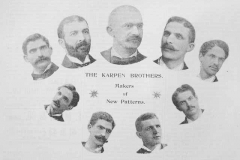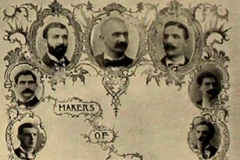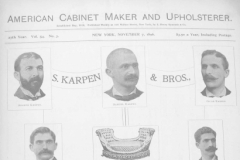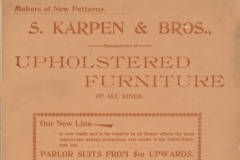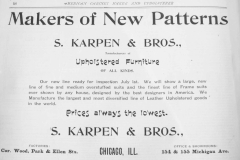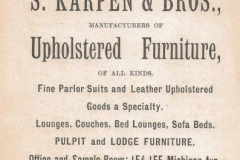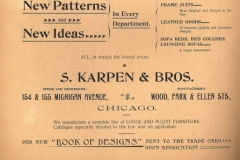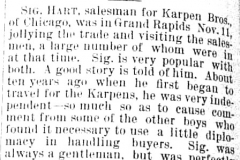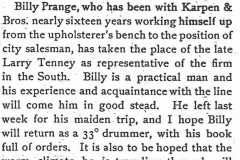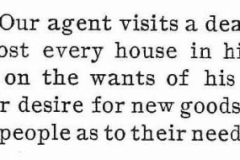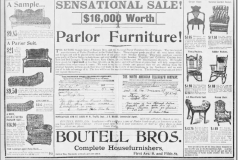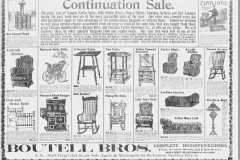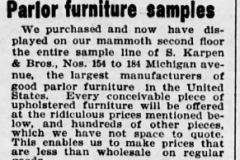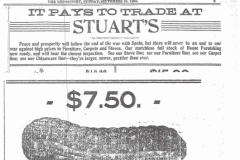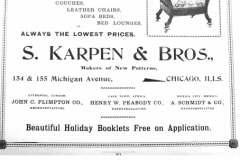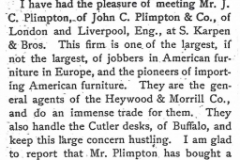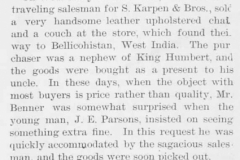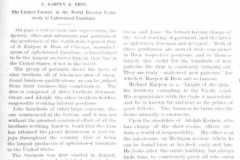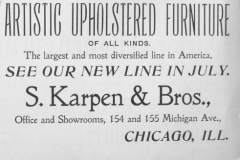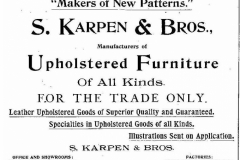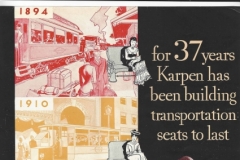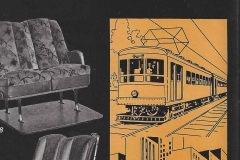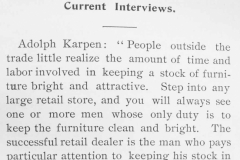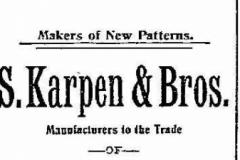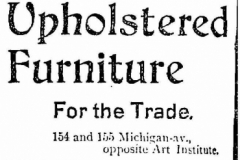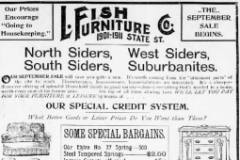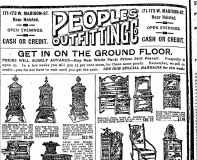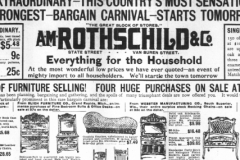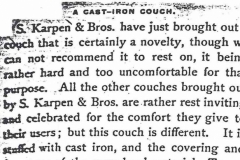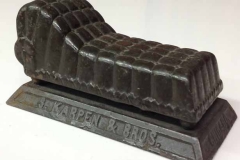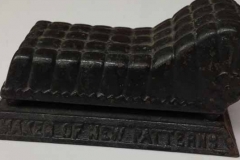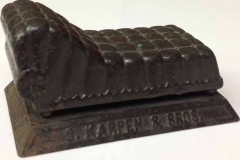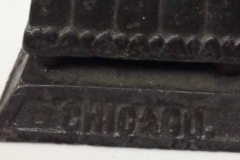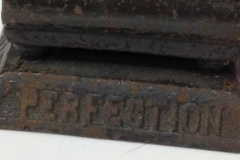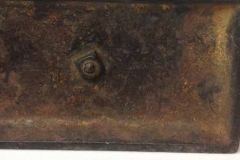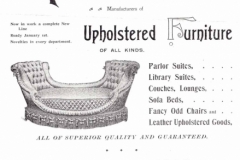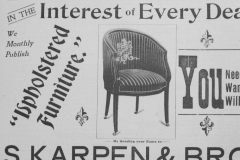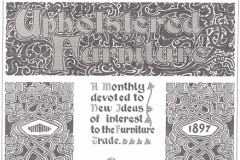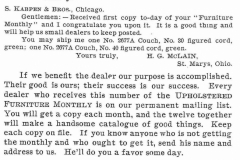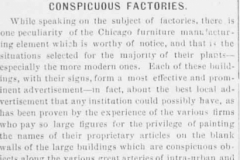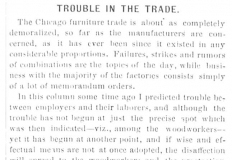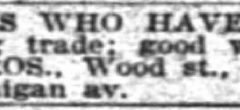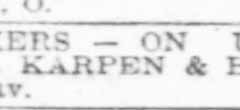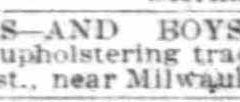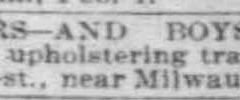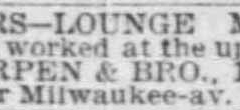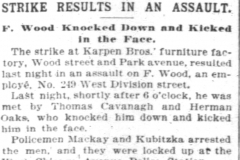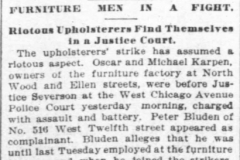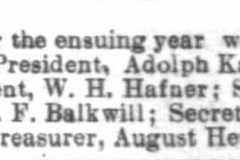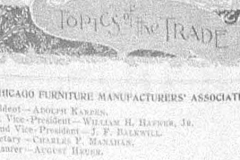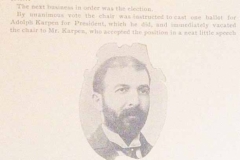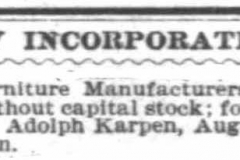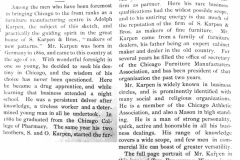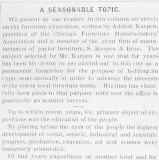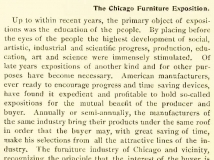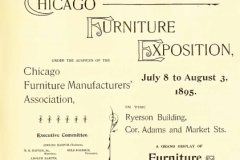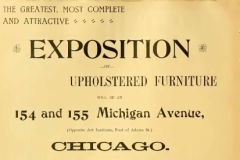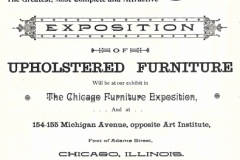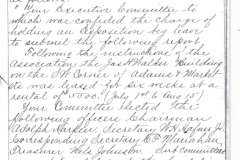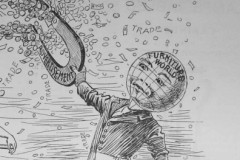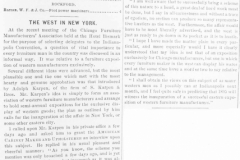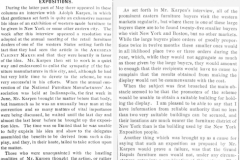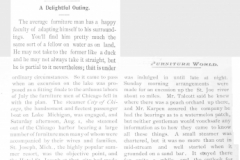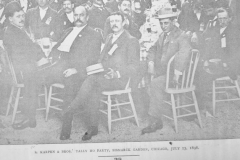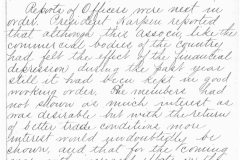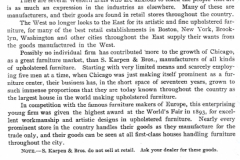Creating the Karpen Brand: 1894-1898
The success of this house has been largely due to the fact that all of the brothers work in perfect harmony. Each has his own particular office to fulfill and he fills it, too.—American Cabinet Maker and Upholsterer, July 28, 1894, 20.
The Karpen Brothers
Roles of the Brothers, 1894:
Adolph has charge of the office and showrooms on Michigan avenue, where he not only superintends the actual selling of goods, but has charge of all the many other things of a nature likely to occupy a man at the head of such a concern as S. Karpen & Bros. Solomon has charge of the factories. He is ably assisted by Oscar, who also acts in the capacity of buyer. Isaac is foreman. Benjamin is the head salesman. Michael is on the road twelve months a year, and he disposes of a few carloads of goods during that period. Leopold is the city solicitor. William is head bookkeeper and cashier, and Julius is his able lieutenant. Taken collectively or singly, they are always courteous, genial and considerate, and when a customer enters the portals of 154 Michigan avenue he may rest assured that he will be allowed to state what he wants, and he will be shown it. One very potent fact in the great success of this business is that they make a study of their customers’ wants, and when a dealer once becomes a customer of S. Karpen & Bros., the chances are he will ever remain with them. “Long life and prosperity” is our toast to the house of Karpen! [1]
After Benjamin Karpen’s death January 10, 1896:
Work of the Brothers [November 1896].
Solomon Karpen has full charge for the factory, looks after buying stock and superintends the manufacturing part of the business. In this work he is ably assisted, however, by Isaac, the former having charge of the wood-working department, and the latter as upholstery foreman and designer. Both of these gentlemen are men of wide experience in their respective positions, and to them is largely due credit for the hundreds of new patterns the firm is constantly bringing out. They are truly “makers of new patterns,” for which S. Karpen & Bros. are so famous.
Michael Karpen is a “knight of the grip,” his territory extending to the Pacific coast. His acquaintance with the trade is marvelous, and he is known far and near as the prince of good fellows. The business he turns into the house annually is enormous.
Upon the shoulders of Adolph Karpen, who has charge of the show-rooms, offices, etc., rests a world of responsibility. His office is at the salesrooms on Michigan avenue, where he can be found busy at this desk early and late. He looks after the entire building, but always finds time to courteously greet all who enter his office, no matter how pressing his duties are. It has often been said that Adolph Karpen was the best-known man in the furniture trade in the West. He is the president of the Chicago Furniture Manufacturers’ Association, and is always willing and ready to give his personal attention to further the interest of the furniture trade. To him much credit is due for the upbuilding of the parlor furniture industry of Chicago.
William Karpen is the credit man for the concern, and he has charge of the office force. While his duties do not bring him prominently before the trade, he is none the less popular with the people who know and work with him. As a credit man, his equal would be hard to find. His position, just now, is certainly not an easy one. He is assisted in his office duties by Julius Karpen, who, by the way, is an attorney at law. All legal points are referred to him, and, as a matter of fact, the firm’s interest is carefully guarded. He is a conscientious, painstaking man in all he undertakes, making his services quite indispensable.
Leopold Karpen is perhaps as well known by the retail furniture trade of Chicago as any man in the business. He has charge of the city trade, and looks after it well. Because of his pleasant manners and fair treatment to the trade, he is well thought of, and he has little trouble in booking orders when there is any demand for goods.[2]
As well as running the manufacturing Solomon made frequent business trips to the Eastern fabric mills and importers of upholstery fabrics.[3]
Through 1895, Benjamin was the head salesman and covered the western states. William, who up to now had worked in the office as a credit man and bookkeeper, replaced the deceased Benjamin as the salesman for its Western Branch, including the States of Illinois, Missouri, Kansas, Nebraska, part of Michigan, and Wisconsin. [4]
Michael traveled constantly in the northwest and far west.[5] “His acquaintance with the trade is marvelous, and he is known far and near as the prince of good fellows. The business he turns into the house annually is enormous.”[6] He recalled decades later, “I first called on Barker Brothers [in Los Angeles]—their buyer in those days was Joe Barker. I sold him a carload of Karpen furniture on my first visit.”[7]
With the closing of the World’s Columbian Exposition in fall 1893, the award-winning Karpen Bros.’ prospects were bright. It enlarged and remodeled its office incorporating a re-construction of part of its World’s Fair exhibit.[8] Everything was set to increase Karpen’s sales throughout the country by building on its success at the World’s Fair. Events in Chicago and the country, however, thwarted this plan.
A prominent furniture manufacturer’s advertisement summarized the dire situation in Chicago: “A World’s Fair Dump. World’s Fair schemes of fabulous proportions urged the over-production of Furniture which faces Chicago today.”[9] Speculators built hundreds of hotels, apartment houses, and boarding houses to accommodate the estimated surge of visitors to the Fair, but high prices and poor attendance made the investments precarious at best. Not surprisingly, many closed rapidly after the Fair concluded, and sought to recoup part of their investment by selling the furnishings to the Chicago public.[10] But no market existed, and a glut of furniture remained on the market.
To compound that situation, “subsequent to the World’s Fair, Chicago [and the rest of the country] passed through another panic…and it proved the longest and most stringent experienced up to that time.”[11] Decades later, Solomon explained what happened:
“I recall the panic of 1893 very vividly. We had always made it a practice to get cash for our goods and to keep it turning over quickly — once a month. We saw all about us firms failing and money getting scarce and my brothers and I thought it wise to arrange for credit in case we should need it.”[12] “In 1893 we had to tighten our belts some; if I remember correctly, we ended that year without a profit. But at no time were we in the least danger of failing.”[13] Other Chicago businesses, however, could not survive the depression. One hundred forty furniture business failures were reported in 1894,[14] and 121 furniture business failed in 1895.[15]
Karpen Bros.’ responded to the difficult situation by expanding and innovating. In early 1894, it took over another floor in its building, making five in all, [16] covering a floor space of 35,000 square feet. [17]
With the dire situation in Chicago, the orders mailed or telegraphed in from its traveling sales force were even more crucial. The men would travel by train in the fall and spring for weeks at a time. In election years, the salesmen were pulled off the road at the end of October to return to Chicago to vote, [18] and would return to the road after the elections when “the campaign of politics is over—the campaign of business is now upon us,” and doubt and uncertainty dispelled.[19]
Sigmund, “Sig” Fish and his brother, Alex, covered New York and New England, and Sig even traveled to Bermuda.[20] Sig was married to Nettie Ohnstein, and Alex’s wife was Solomon’s sister-in-law, Annie Schwalbe. It was reported that Sig Fish, for instance, “returned home for the summer, and is dividing his time between figuring out his next trip and in playing with the baby.”[21] Sig won third prize in the salesmen’s contest securing his high place in the race, and the prize of a gold match safe, by the strong support of the furniture contingent between New York and Chicago.[22]
Karpen Bros. promoted from within. When Larry Tenney who covered the south, southwest and Texas died of apoplexy while on the road,[23] Billy Prange, who had been with Karpen & Bros. nearly sixteen years working himself up from the upholsterer’s bench to the position of city salesman, took over his responsibilities.[24] R. Mahnke, formerly in the factory, became one of the salesmen in their Michigan avenue salesroom; “judging from his bright, pleasant manners he will make a success.”[25] The trade journals reported about the Karpen Bros.’ salesmen; the company also touted their sales force:
Karpen Bros.’s marketing policy was to sell to only one retailer in each town or city. These retail stores began to feature Karpen Bros. furniture in their newspaper advertisements. In 1894 stores included “Karpentine” fabric in their list of upholstery fabrics offered while not mentioning Karpen Bros. by name. From 1895, furniture stores in the Midwest and East advertised special Karpen furniture sales:
At the end of 1898, Karpen Bros. open agency relationships in Liverpool and London; Cape Town, South Africa; and Mexico:[26]
The trade papers reported an even more unusual international sale:
The trade press commented on the company’s attitude: “S. Karpen & Bros. have nothing to complain of. In fact that firm doesn’t do much complaining. They have wisely long ago concluded that the energy expended in complaining can be better employed in “hustling.” It pays better. This policy, together with the fine line of goods they offer to trade, has made for the house the success which has rewarded their efforts.”[27] While not being overly cocky, Adolph always assured the trade press that business was “good and steadily growing better…After the slough into which we were thrust, we require a slow, healthy increase to restore confidence.”[28] “We have about all the business we can comfortably handle, and every mail brings in a few orders. But I do not wish to be understood as saying we are enjoying a “boom,” for we are not.” [29]
A long article in a furniture trade journal told the history of the company including the factory and salesroom:
1896 Article about Karpen Bros.
Karpen Bros. in its advertising started using language like “doing the largest business in our line in the country, enables us to quote lowest prices;”[30] “the largest house with the greatest line of upholstered furniture on earth;”[31] “acknowledged to be the largest exclusive firm in that line in the United States, if not in the world;” [32] and “the largest and most comprehensive line in America at always lowest prices.”[33] These descriptions were taken up by the furniture trade press, but often qualifiers, like “one of the…” were added.
In 1894, S. Karpen & Bros. entered into the transportation seating business. In the early 1890s electric street cars and trolley cars began traveling city streets. The company began manufacturing seat for these new conveyances.
Karpen Bros.’ prestige in Chicago had been cemented by its move to Michigan Avenue in 1892. As the trade press explained, “when Karpen Bros. purchased the building they are now in they had little idea at the time that they were going to bring the trade all around them, but such is the fact.[34] More than seventy-five different lines were exhibited in the Karpen Building and the block of Michigan Avenue and Adams Street.[35] The vicinity of the Karpen block was called in the trade papers “Karpen Corners.”[36]
In an interview Adolph Karpen emphasized the importance showing furniture in the best possible way:
Heeding his own advice, in 1898 Karpen Bros. renovated its five floors in the Karpen Building. It was reported: “painters and decorators have complete possession and when completed the rooms will be both bright and attractive” with new paint and paper.[37] The ground floors where part of the leather goods are shown are treated in a light yellow and decorated with stucco, “producing a very pleasing effect.”[38] The walls have been handsomely frescoed, and the entire ceiling and the side walls are in a pink tint. [39] Their show rooms present a fine appearance making a handsome background for the upholstered goods.[40]
The company constantly needed to draw the buyers to its showrooms. It used its showroom windows and special exhibits to create interest. It exhibited a small hand-carved library case made of Italian walnut, and finished in a combination of Vernis Martin (a varnish patented in France to imitate East Asian lacquer) and gold leaf.”[41] “It also became the sales agent for a line of hand carved goods made in Venice, Italy, consisting mostly of hall and parlor chairs, which were displayed in their show windows and garner much attention.”[42] Another popular window display was an eight foot mahogany cabinet which took two years to be carved by one of their cabinet makers. Four panels across the front are handsomely decorated with pearl inlaid work, each representing some feature in dramatic life. It was probably worth between two and three thousand dollars. [43] Drawing great attention in 1896 was a carved, gold chair, a reproduction of the pontifical chair at Rome, valued at $240.”[44]
Karpen Bros. was astute in the ways to treat buyers— provide better customer care than other concerns. The brothers, “taken collectively or singly, they were always courteous, genial and considerate, and when a customer entered the portals of 154 Michigan avenue he may rest assured that he will be allowed to state what he wants, and he will be shown it. One very potent fact in the great success of this business is that they make a study of their customers’ wants, and when a dealer once becomes a customer of S. Karpen & Bros., the chances are he will ever remain with them.”[45] “Besides the large line of parlor goods dealers had a chance to see, they were highly entertained as the travelers for this house know how to do the honors. All the boys are off the road, and they are entertainers from way back.”[46]
It was Leo’s challenging task, as salesman for the “city trade,” to bolster sales to Chicago dealers.[47] Occasionally small display advertisements were placed in the local papers. Chicago retail stores, like A.M. Rothschild & Co. at State Street at Van Buren Street[48] and Peoples’ Outfitters’ advertisements did feature Karpen pieces but always at considerable discounts. [49]
Karpen Bros. increased its advertising coverage and initiated innovative projects to broaden its exposure to retailers.
Many manufacturers gave incentive gifts to retailers and agents. Karpen Bros. produced this clever advertising letter weight.
The company paid extra to have its advertisements placed on the front and back covers of the furniture trade journals.
In 1897 Karpen Bros. published its first issue of a monthly magazine/catalog entitled, Upholstered Furniture.[50] As reported in the trade press, “the June issue of “Karpen’s Upholstered Monthly” is a beautiful book, full of new ideas, gotten up by this enterprising firm. They issue this book solely for their own interest, to get the trade better acquainted with the new things they are constantly getting out. The cuts are all half-tone and printed on good paper.”[51]
Another report stated, “the June issue of their monthly catalog was mailed. It excels all the firmer issues in attractiveness. This is an enterprise not shared in, we believe, by any other firm in the world of any industry. It is characteristic of this firm.” [52] In its advertisements, all dealers were encouraged to send for a free copy. [53] The company mailed thirty-six hundred copies to the trade.”[54] Julius was in charge of the November issue that highlighted, perhaps the largest line of y furniture ever before offered, including some very handsome pieces in gilt frame and decorated work.”[55] It is not known how many issues of Upholstered Furniture were published, and only one issue has been located.
The furniture business in Chicago faced an additional crisis in 1896 when the Upholsterers’ Union struck the furniture factories again. [56] The immense Karpen factory was the most complete in the country and was equipped with the best and latest machinery. It employed from 300 to 400 men;[57] some accounts reported 450 workers. With this size workforce, the labor issues confronting industrial factories could not be avoided. In January 1896, the upholsterers’ union went on strike in the Karpen and other factories:
The furniture trade newspapers and the Chicago newspapers, of course, followed the situation day by day. At issue were the employers, still under the umbrella of the Manufacturers Association, who were determined to make the change from piece work and to require the men to work 10 hours each day. The wage for the day’s work was $2. The Upholsterers’ Union asked that the day be cut to eight hours, and all work be paid for by the piece.[58]
“The Chicago furniture trade was about as completely demoralized; failures, strikes and rumors of combinations are the topics of the day, while business with the majority of the factories consists simply of a lot of memorandum orders. Every firm in the city engaged in the manufacture of upholstered goods is involved in the trouble, and work in their factories at the present writing is at a standstill.”[59] If the strikers desired their former positions nothing could induce the manufacturers to re-instate them. Their positions were all filled and every establishment is working with a full complement of non-union and union men, working for $3.50 a day.[60]
Several confrontations occurred at the factories. A workman in S. Karpen & Bros.’ factory was assaulted by strikers and quite seriously beaten.[61] The Chicago Tribune reported another incident involving Oscar and Mike:
Eugene V. Debs, called “the great labor agitator” by a furniture trade journal, spoke to several groups of strikers.[62] Although the local strikers received some financial support from other unions, they were in desperate straits. One striker admitted that “he didn’t have a cent to his name, and that he had a family of four to support. His wife has had to take in washing since the strike opened up.”[63]
Adolph was on the Manufacturers Committee that met with the State Arbitration Committee and the strikers; the manufacturers stated they had nothing to arbitrate.[64] After 14 weeks, the strike was settled. “All the old men formerly employed by the various upholstery manufacturers returned to their benches unsolicited, remarking that they were glad to get a job. This is chronicled as a complete victory of the Manufacturers Association as the men go to work at the time and prices dictated by its members.”[65]
Karpen Bros. was an enthusiastic supporter of public events and parades. It usually made a big splash garnering praise from the Chicago newspapers and trade press. Such a major event was the parade on Chicago Day, October 6, 1896 which proclaimed two purposes: “the 25th anniversary of the great fire which swept over the city, leaving death and ruin in its pathway” and “a great demonstration to announce to the world their position on the money question. It was a sound money parade in the extreme, and was composed of men in every walk in life. Business men, mechanics and the laboring men marched side by side, showing how closely allied one is to the other in the great conflict that confronts every American citizen—that of earning an honest living, the Democratic party to the contrary, notwithstanding.” [66] A Chicago Tribune Editorial wrote that the “Demonstration on October 9th was a protest against the “National villainy contemplated by the free silver Popocratic mob led by Bryan. Smaller one is planned for November. …It would be a worse blow to Chicago than the great fire of 1871, and a greater destroyer of actual values.”[67]
Solomon served on the Committee of One Hundred, chosen to take charge of arrangements for the parade and demonstration for the sound money cause. This group served under the Business-Men’s Sound Money Association. Companies invited their employees to form sound money clubs,[68] and Karpen Bros. had such a club.
The Chicago papers estimated that more than 100,000 people from most of the companies in the city and surroundings participated: [69] All the business houses closed for the day. The parade, which was the largest ever witnessed in Chicago, occupied the down-town streets from 10 o’clock in the morning until 4.15 in the afternoon. [70] The cheering for McKinley along the line of march was almost deafening. Marchers carried canes, umbrellas, flags; they wore caps, capes and other paraphernalia, all of which in one way or another represented gold. [71] One float represented five countries, including the United States with a gold standard and prosperity; the other float was a cart drawn by a donkey, displaying the Mexican dollars. On a banner were the words “worth 51 cents or any old thing. Both floats were very suggestive of the occasion, and they elicited much favorable comment along the line of the parade.” [72]
Furniture manufacturers were prominent. From Karpen Bros.’ factory, 325 employees marched; an equally large proportion represented the other factories to number 5,000.[73] “Four of the Karpen Bros. rode bicycles of peculiar construction. Instead of riding tandem they rode side by side with an immense canopy over them. The sight of two men of unequal weight balancing themselves on the regulation bicycle was both unique and interesting.”[74] “A unique and striking feature was the number and character of floats emblematic of the furniture industry. Of these the one furnished by S. Karpen & Bros. surpassed them all in finish and design. It was in the form of a pagoda, with the overhanging canopy draped in purple plush looped with gold cord and tassels. Underneath the canopy stood a large chair imported from Venice, Italy, and an exact copy of the Papal chair in the Vatican used by the Pope when engaged in his official duties.” The high back chair[75] was of Venetian walnut, hand carved and finished in gold. [76] It was christened “the McKinley chair” was subsequently exhibited in its showrooms.[77]
As well as attending to the needs of Karpen Bros., Adolph continued his untiring efforts to promote The Chicago Furniture Manufacturers Association (CFMA).
The CFMA elected Adolph president in 1895 and 1896 (with 13 of the 22 votes).[78] He was called “the best posted parliamentarian in the vicinity.”[79] Adolph’s new position brought more prestige to the company:
Those years were difficult for the CFMA. So low was the level of interest that the trade press reported that a regular meeting… “brought out two worn and weary newspaper reporters. The furniture manufacturers were conspicuous by their absence.”[80]
Another disappointment was the poor attendance at The Eighth Annual Convention of National Association of Furniture Manufacturers in Chicago. Nevertheless, “Adolph Karpen’s voice was heard on every question, and his outspoken utterances met with hearty favor;” his most pithy phrase—“Chicago is the Hub of the United States.”[81]
Although the market outlook remained weak and the manufacturers were scrambling to get their pre-strike orders filled, the Association decided to mount a furniture exposition and elected Adolph as chairman. [82] Adolph was again the liaison listed in the advertisements and was on hand during the event.[83] His photo appeared in a Chicago newspaper.[84] While the forecast was for 1,500 buyers to place strong orders, only 915 registered and the orders were not as expected.[85] Karpen Bros. advertised heavily before the exposition for its “magnificent new line ready July 1st.”[86]
The furniture trade journals highlighted Adolph’s important contributions with interviews and feature articles. A cartoon with Adolph was captioned, “A stronger effect should be made to attract more trade to Chicago.”[87] His goal was to develop the West as a competitor to New York and the eastern markets:
In 1896 two expositions were planned for Chicago. However, Adolph publicly stated that although “the exposition is a good thing, as it brings the furniture people together, but it cannot interest the downtown furniture people, as they all have handsome showrooms of their own and can do the trade and themselves more justice than they could at an exposition, and for this reason our firm will not show.’”[88] Also, the association decided not to mount the exposition that had been planned because sales during a presidential election year were “always dull.”[89]
The furniture association like other business enterprises socialized usually only with their male business contacts. Certain events, however, included wives and girl friends. As president, Adolph led the way on a typical summer excursion; his wife joined him for the event:
Karpen Bros., with Adolph coordinating the efforts via the entertainment committee, extended hospitality to four hundred national furniture dealers at their 1898 convention, with a banquet at the new Auditorium Hotel.[90] The next day some of “the delegates took coach rides over the most important boulevards and through the largest parks in the city, and afterwards inspected the Karpen furniture factory in Michigan avenue, where luncheon was served.”[91]
After serving his second 1-year term as president, Adolph gave the 1896 annual report:
Adolph declined to be a candidate for re-election in 1897. The Chicago Furniture Manufacturers Association then “thanked President Karpen for the able and impartial manner in which he had discharged the office of President. The motion being put by the Secretary was carried unanimously by a rising voluntarily.” [92]The German-language Illinois newspaper, Illinois Staats-Zeitung, reported about the Association’s annual meeting, stating that Adolph, president in 1896, gave his report.
In the years following the World’s Columbian Exposition, the stature of Chicago as the leader in furniture production was secured. While the statistics varied considerably, “few people knew that Chicago is the largest furniture manufacturing city in the world.” Between 250[93]-270[94] factories engaged in making furniture and kindred articles. From 10,000[95] to 25,000[96] people were employed in the industry. Forty-eight manufacturers, including Karpen Bros., produced parlor goods,[97] with an estimated value of $20,000,000[98] to $22,000,000[99] or even to $30,000,000.[100]
Chicago passed Grand Rapids in this its greatest industry.[101] In parlor furniture especially Chicago has attained the position of the chief furniture market of the world; the annual sales of upholstered goods and frames equaled those of New York, Boston and Cincinnati combined.”[102] It was indeed “Chicago’s Great Industry” [103] and “Chicago was the largest manufacturing center in the world.” [104]
The trade newspapers explained why Chicago experienced industrial growth in these years, and not surprisingly Karpen Bros. played an important role:
S. Karpen & Bros. built upon the momentum of its success at the World’s Columbian Exhibition. Despite the difficult economic times, the company expanded and created the Karpen brand. It was posed for major changes in 1899.
- American Cabinet Maker and Upholsterer, July 28, 1894, 20. ↑
- American Cabinet Maker and Upholsterer, Nov. 7, 1896, 13. ↑
- Furniture Worker, Dec. 10, 1897, 25. ↑
- American Cabinet Maker and Upholsterer, June 26, 1897) 39. American Cabinet Maker and Upholsterer, Aug. 7, 1897, 12. Furniture World, Oct. 27. 1898, 25. ↑
- American Cabinet Maker and Upholsterer, May 9, 1896, 19. ↑
- American Cabinet Maker and Upholsterer, Nov. 7, 1896, 13. ↑
- Mike Karpen in “16,500 Furniture Workers: S. Karpen Factories,” Southern California Forum , Mar. 11, 1949, 4. ↑
- American Cabinet Maker and Upholsterer, Sept. 2, 1893) 14. American Cabinet Maker and Upholsterer, Dec. 2, 1893, 12. ↑
- Chicago Daily Tribune, Sept. 5, 1893. ↑
- Chicago Daily Tribune, Nov. 6, 1893. ↑
- Chicago Furniture Manufacturers Association. “Chicago Furniture Manufacturers Association: 50 Forward Years 1888-1938.” Chicago: Furniture Manufacturers Association, 1938, 11. ↑
- Solomon Karpen in, Carl Saunders, “They Called Us Crazy, but ─,”[An Interview with Sam Karpen] Furniture Manufacturer, September, 1930, [2]. (reprinted by S. Karpen & Bros, “Karpen Celebrates Half Century of Service.”) ↑
- Solomon Karpen in Neil Clark, “How Nine Brothers Built Up a $10,000,000 Business,” Forbes, Aug. 1, 1926, 34. ↑
- Furniture World, Jan. 13, 1895, 29. ↑
- Furniture World, Jan. 13, 1898, 29. ↑
- American Cabinet Maker and Upholsterer, Jan. 13, 1894) 16. American Cabinet Maker and Upholsterer, Feb. 10, 1894, 15. ↑
- American Cabinet Maker and Upholsterer, Jan. 5, 1895, 32. ↑
- Furniture World, Oct. 29, 1896, 22. Furniture World, Oct. 29, 1896, 22. ↑
- Furniture World, Nov. 12, 1896, 21. ↑
- Furniture World, Apr. 9, 1896) 23. American Cabinet Maker and Upholsterer, Apr. 18, 1896, 11. Furniture World, Nov. 4, 1897) n.p. in Furniture World, Nov. 3, 1927, 9. ↑
- Furniture World, June 4, 1896, 23. ↑
- Furniture World, Feb. 27, 1902, 7. American Cabinet Maker and Upholsterer, Feb. 27, 1897, 23. ↑
- Furniture World, Nov. 12, 1896) 22; July 30, 1896, 27; Sept. 22, 1898, 19. American Cabinet Maker and Upholsterer, Apr. 28, 1894, 16; Aug. 7, 1897, 12. ↑
- Furniture Worker, Oct. 25, 1898, 20. ↑
- Furniture Worker, Nov. 10, 1898, 22. ↑
- Furniture World, Dec. 29, 1898, 47. ↑
- American Cabinet Maker and Upholsterer, Dec. 7, 1895, 18. ↑
- American Cabinet Maker and Upholsterer, Mar. 3, 1894, 15. ↑
- American Cabinet Maker and Upholsterer, Apr. 7, 1894, 14. ↑
- Furniture World, June 18, 1896, 14; June 25, 1896, 26; July 2, 1896, 19; July 9, 1896, 32. ↑
- Furniture Trade Review and Interior Decorator, July 10, 1896, 52. ↑
- American Cabinet Maker and Upholsterer, Nov. 7, 1896, 13. ↑
- Furniture Trade Review and Interior Decorator, July 10, 1896, 15. ↑
- Furniture Trade Review and Interior Decorator, Feb. 10, 1897, 44c. Furniture Trade Review and Interior Decorator, Jan. 10, 1898, 50. ↑
- Furniture Worker, Dec. 10, 1897, 26. ↑
- Furniture World, Dec. 23, 1897, 30-31. ↑
- Furniture World, June 23, 1898, 31. Furniture World, June 30, 1898, 47. ↑
- Furniture Worker, July 10, 1898, 26. ↑
- Furniture Trade Review and Interior Decorator, July 10, 1898, 57. American Cabinet Maker and Upholsterer, July 10, 1897, 52. ↑
- American Furniture Gazette, July 1898, I. American Cabinet Maker and Upholsterer, July 3, 1897, 38. ↑
- Furniture World, Oct. 1, 1896, 21. ↑
- Furniture World, Oct. 3, 1895, 22. American Cabinet Maker and Upholsterer, May 30, 1896, 16. American Cabinet Maker and Upholsterer, May 9, 1896, 19. ↑
- American Cabinet Maker and Upholsterer, Apr. 17, 1897, 21. ↑
- Furniture World, Nov. 19, 1896, 16. Furniture World, May 28, 1896, 26. Furniture World, June 11, 1896, [28][26]. ↑
- American Cabinet Maker and Upholsterer, July 28, 1894, 20. ↑
- American Cabinet Maker and Upholsterer, July 17, 1897, 36. ↑
- American Cabinet Maker and Upholsterer, July 28, 1894, 20. ↑
- Chicago Daily Tribune, Apr. 25, 1897; May 2, 1897. ↑
- L. Fish Co. advertisement in Chicago Daily Tribune, Sept. 16, 1894. ↑
- Furniture World, Apr. 22, 1897, 19. ↑
- Furniture Trade Review and Interior Decorator, Jun. 10, 1897, 61. ↑
- Furniture Worker, June 10, 1897, 28. ↑
- Furniture World, June 17, 1897, 27; June 24, 1897, 42; July 1, 1897, 16; July 8,1897, 29; July 15, 1897, 25; (July 22, 1897, 1; July 29, 1897, inside back cover-pink cardboard; Aug. 5, 1897, 10. ↑
- American Cabinet Maker and Upholsterer , June 12, 1897, 26. ↑
- American Cabinet Maker & Upholsterer, Nov. 6, 1897, 22. ↑
- American Cabinet Maker and Upholsterer, Feb. 1, 1895, 13. ↑
- Furniture World, May 14, 1896, 20. American Cabinet Maker and Upholsterer, Aug. 29, 1896, 17. ↑
- American Cabinet Maker and Upholsterer, Jan. 25, 1896, 17-18. ↑
- American Cabinet Maker and Upholsterer, Jan. 25, 1896) 17-18. ↑
- American Cabinet Maker and Upholsterer, Mar. 14, 1896) 13. Furniture World, Feb. 6, 1896, 81. ↑
- Furniture World, Feb. 20, 1896) 25. Chicago Daily Tribune, Feb. 15, 1896. ↑
- Furniture World, Apr. 16, 1896, 19. ↑
- Furniture World, Mar. 12, 1896, 27. ↑
- American Cabinet Maker and Upholsterer, Mar. 14, 1896, 13. ↑
- American Cabinet Maker and Upholsterer, Apr. 25, 1896, 47. ↑
- American Cabinet Maker and Upholsterer, Oct. 17, 1896, 16. ↑
- Chicago Daily Tribune, Oct. 10, 1896. ↑
- Chicago Daily Tribune, Sept. 17, 1896.↑
- Chicago Daily Tribune, Sept. 28, 1896. ↑
- American Cabinet Maker and Upholsterer, Oct. 17, 1896, 16. ↑
- American Cabinet Maker and Upholsterer, Oct. 17, 1896, 16. ↑
- American Cabinet Maker and Upholsterer, Oct. 17, 1896, 16. ↑
- Furniture World, Oct. 15, 1896, 19. Chicago Daily Tribune, Oct. 10, 1896. ↑
- Furniture World, Oct. 15, 1896, 19. ↑
- American Cabinet Maker and Upholsterer, Jan. 2, 1897, 32. ↑
- Furniture World, Oct. 15, 1896, 19. ↑
- American Cabinet Maker and Upholsterer, Jan. 2, 1897, 32. ↑
- Furniture World, Apr. 16, 1896, 20. By-laws February 11, 1896, Chicago Furniture Manufacturers Association, Chicago Furniture Manufacturers Association Files, Box 1, Folder 1, Chicago History Museum Archives. Chicago Daily Tribune, Jan. 31, 1895. Furniture Trade Review and Interior Decorator, Mar. 10, 1896, 47. American Cabinet Maker and Upholsterer, Feb. 9, 1895) 17. American Cabinet Maker and Upholsterer, Feb. 22, 1896, 15. Furniture Trade Review, Mar. 10, 1896, 47. ↑
- Furniture Trade Review and Interior Decorator, Feb. 10, 1895, 42. ↑
- Furniture World, Oct. 29, 1896, 21. ↑
- Furniture World, June 20, 1895, 20-21. ↑
- Minutes, Aug. 27, 1895, p. 91. Chicago Furniture Manufacturers Association, Chicago Furniture Manufacturers Association Files, Box 1, Folder 1, Chicago History Museum Archives. Chicago Daily Tribune, July 7, 1895. ↑
- Furniture World, June 6, 1895, 1; June 20, 1895, 1; June 27, 1895, 20; July 4, 1895, 1. Furniture World, July 11, 1895, 33. ↑
- Furniture World, July 25, 1895, 26. ↑
- Furniture World, July 11, 1895, 33. Furniture World, July 18, 1895, 33. Furniture World, July 25, 1895, 26. ↑
- Furniture World, Apr. 4, 1895) 17; Apr. 11, 1895, 20; Apr. 16, 1895, 16; Apr. 25, 1895, 2. Furniture World, June 6, 1895, 1; June 20, 1895, 1; June 27, 1895, 20; July 4, 1895, 1. ↑
- Furniture World, Mar. 12, 1896, 27. ↑
- American Cabinet Maker and Upholsterer, May 30, 1896, 13. ↑
- Furniture World, Feb.6, 896) 82. Furniture World, Jan. 9, 1896, 45. Furniture World, Apr. 2, 1896, 26-7. ↑
- Chicago Daily Tribune, July 13, 1898. ↑
- Chicago Daily Tribune, July 13, 1898; July 14, 1898. ↑
- Minutes, February 2, 1897, p. 104. Chicago Furniture Manufacturers’ Association, Chicago Furniture Manufacturers’ Association Files, Box 1, Folder 1, Chicago Historical Society Archives. Furniture Trade Review, Feb. 10, 1897, 44b. American Cabinet Maker and Upholsterer, July 28, 1894, 20. ↑
- Furniture World. Aug. 1, 1895, 26. ↑
- Chicago Daily Tribune, Feb. 3, 1895, 1. ↑
- Furniture World, June 24, 1897, 41. ↑
- Furniture World, Aug. 1, 1895, 26. ↑
- Furniture World, Aug. 1, 1895, 26. ↑
- Furniture World, June 24, 1897, 41. ↑
- Furniture World, Jan. 9, 1896, 45. ↑
- Chicago Daily Tribune, Feb. 3, 1895, 1. ↑
- Furniture World, Aug. 1, 1895, 26. ↑
- Furniture World, June 24, 1897, 41. ↑
- Furniture World, June 24, 1897, 41. ↑
- Chicago Daily Tribune, Feb. 3, 1895, 1. ↑
